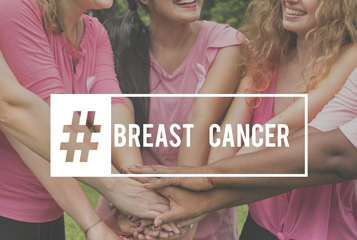 Breast cancer occurs when breast cells grow abnormally. It is the most common cancer diagnosed in the US after skin cancer. There are different types of breast cancer based on the particular cells in the breast that are affected. Nearly all breast cancers are carcinomas, or tumors that start in the epithelial cells lining the organs and tissues in the body. When carcinomas form in the breasts, they are called adenocarcinoma. Tumors first appear in cells in the milk ducts or the milk-producing glands.
Breast cancer occurs when breast cells grow abnormally. It is the most common cancer diagnosed in the US after skin cancer. There are different types of breast cancer based on the particular cells in the breast that are affected. Nearly all breast cancers are carcinomas, or tumors that start in the epithelial cells lining the organs and tissues in the body. When carcinomas form in the breasts, they are called adenocarcinoma. Tumors first appear in cells in the milk ducts or the milk-producing glands.
There are many types and subtypes of breast cancer:
Types of Breast Cancer
- Non-Invasive Breast Cancers: These cancers are present in the milk ducts or lobules in the breast. They haven’t spread out of the milk duct and have a low risk of becoming invasive. Non-invasive cancers are called carcinoma in situ and are sometimes referred to as pre-cancers. The two types of non-invasive cancers are:
- Ductal Carcinoma in Situ: This is the most common type of non-invasive breast cancer. DCIS starts in the breast’s milk ducts and does not spread into any surrounding tissues as it is non-invasive. DCIS is not life-threatening, but having it can increase your chance of having invasive breast cancer later.
- Lobular Carcinoma in Situ: LCIS is not cancer. It is an uncommon condition in which cells grow abnormally in the breast’s milk glands (lobules). If you are digonosed with LCIS, it shows you have an increased risk of developing breast cancer.
- Invasive Breast Cancers: These are cancers that have spread outside the ducts or lobules of the breast into the breast tissues surrounding it. ‘Early breast cancer’ is refers to cancer in the breast that may have spread to surrounding lymph nodes in the breast or armpit but not anywhere else in the body.
- Invasive Ductal Carcinoma: Cancer cells grow outside the ducts and spread into other parts of the breast tissue. Invasive cancer cells can also spread, metastasize, to other body parts. IDC is the most common form of breast cancer and represents 80% of all breast cancer diagnoses.
- Invasive Lobular Carcinoma: ILC is the second most common type of breast cancer after IDC. The cancer cells spread from the milk glands to the nearby breast tissues. Over time, it can also spread to other parts of the body.
- Paget’s Disease of the Nipple or Paget’s Disease of the Breast: This is a rare condition associated with breast cancer. Eczema-like changes will happen to the nipple skin and the area surrounding the nipple. Usually, it is a sign of breast cancer in the tissue behind the nipple.
- Inflammatory Breast Cancer: Inflammatory breast cancer is a rare and aggressive form of invasive breast cancer. It affects the blood vessels in the skin and/or lymphatic vessels of the breast. Although IBC is often a type of IDC, its symptoms, outlook, and treatment differs from other breast cancer types.
- Phyllodes Tumors of the Breast: They are an unsusal presentation of breast cancer. Some phyllodes tumors are cancerous. They are a form of sarcoma and grow in the connective tissues of the breast, not in the ducts. They tend to grow fast, but rarely spread outside the breast. Phyllodes tumors are a rare cancer and confirmation is required by a second pathologist.
- Locally Advanced Breast Cancer: Locally advanced breast cancer is large or has spread to other surrounding areas like skin, muscle, or chest wall and have extensive local lymph node involvement.
- Metastatic Breast Cancer: Metastatic breast cancer is also called stage IV breast cancer that has spread to other parts of the body. The cancer cells of the original tumor in the breasts break away and travel to other parts of the body through the bloodstream or the lymphatic system especially to the liver, bones, brain, or lungs.
Subtypes of Breast Cancer
Subtypes are based on the genes a cancer expresses.
- Hormone Receptor Positive Breast Cancer: This type of cancer needs female hormones such as estrogen and progesterone to grow and reproduce. Hormone therapy drugs that lower estrogen levels or block estrogen receptors are used to treat this type of breast cancer.
- HER2 Positive Breast Cancer: This is a type of breast cancer that tests positive for a protein called human epidermal growth factor receptor 2 (HER2). It promotes cancer cell growth. This type of cancer is said to be more aggressive than other breast cancer types. A drug called Herceptin is used to treat HER2 positive breast cancer and has proven a very effective treatment.
- Triple-Negative Breast Cancer: Triple-negative breast cancer does not have receptors like estrogen, progesterone, and HER2 protein that are usually found in other breast cancers. This means that traditional breast cancer treatment or hormone therapy would not be effective to treat this cancer type. Here the patient requires chemotherapy, targeted therapy, and radiation.
Breast cancer is not a single disease. As there are different types and subtypes of this disease, the treatment that a patient receives for her breast cancer will differ. There are risk factors of breast cancer that you can change and cannot change. Understand them and take appropriate steps to detect breast cancer early to reduce disease risk.